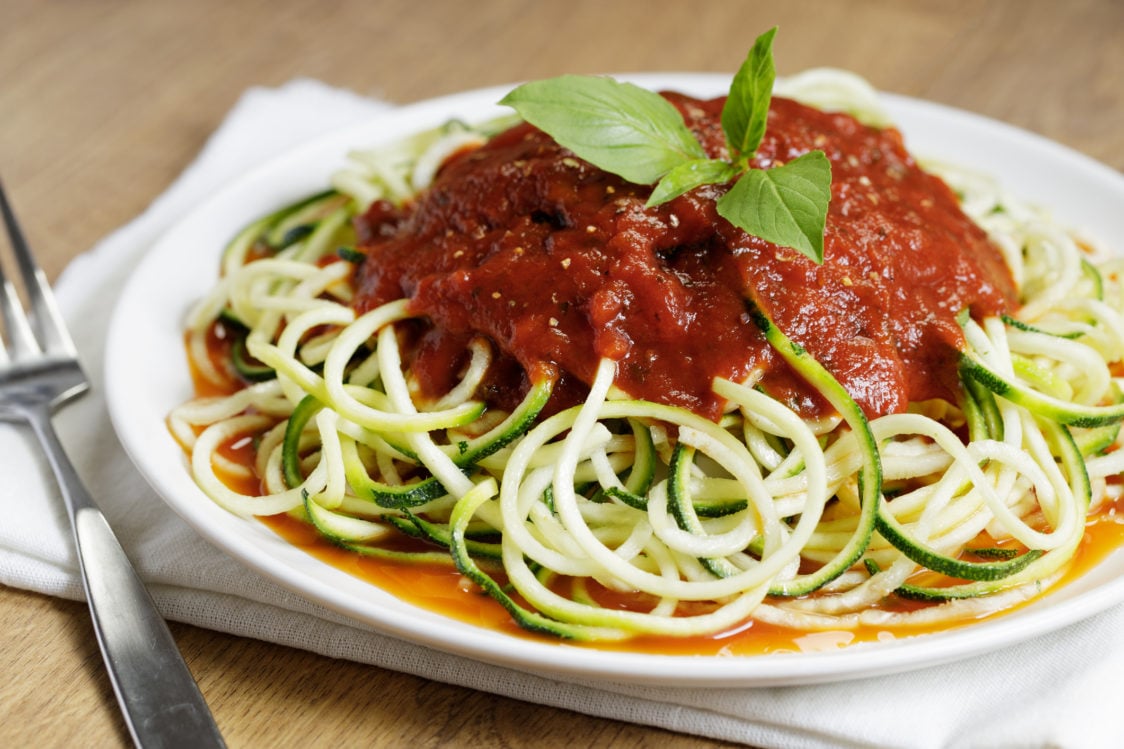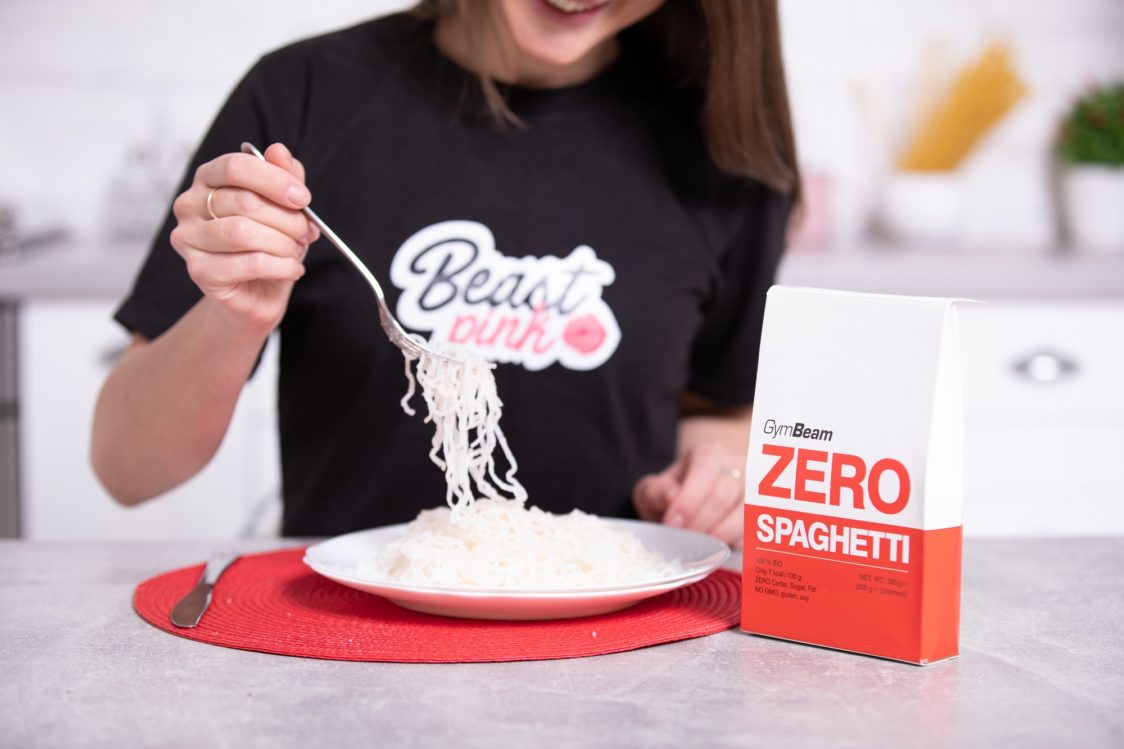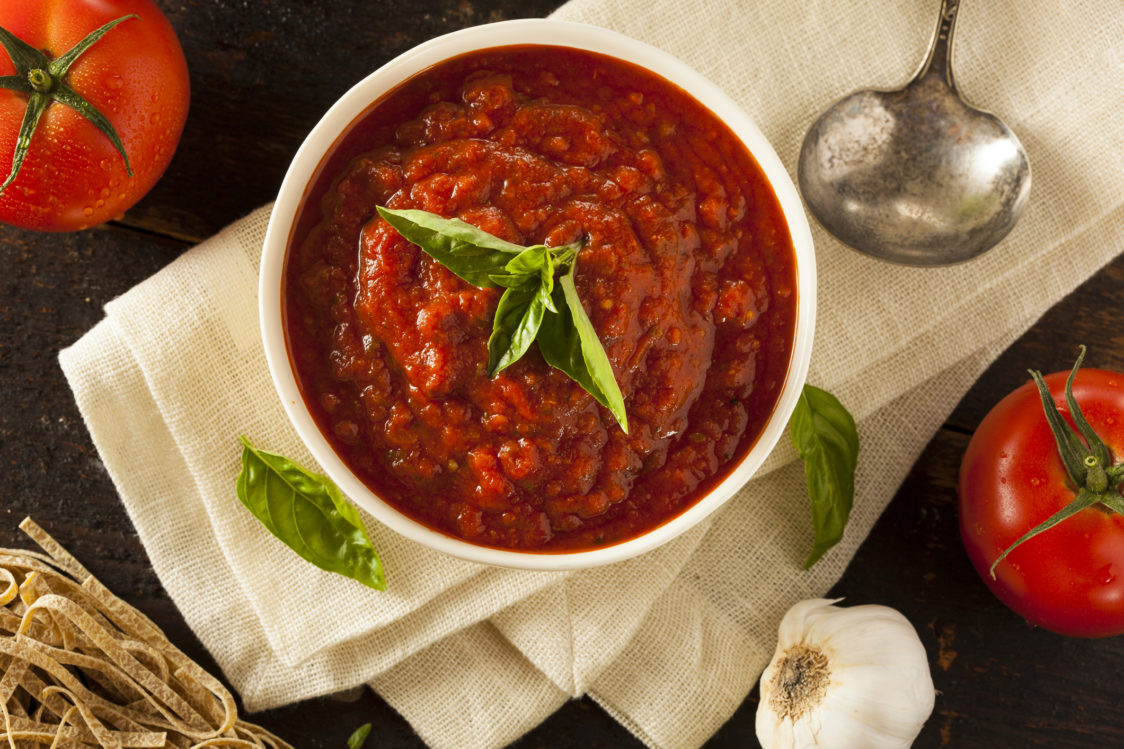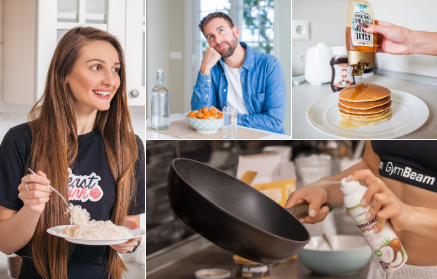Table of Contents
Cream sauce with melted cheddar, fries or a sweet dessert rich in sugar. Is there anyone who is not attracted to the idea of at least one of these goodies? If so, you’ve won. But I dare say that each of us has some favourite foods that we know to be calorie-rich, and yet we’d like to eat them every day. Sure, eating a cake during a cheat day once in a while is no sin, but if you want to lose weight, it’s probably not the best idea to have it on your menu every day. In today’s article, we’ll give you some tips on how to replace sugar, side dishes and your favourite sauces to reduce the caloric value of the resulting meal so that you can lose weight more easily.
Why include less caloric versions of food when losing weight?
If you want to lose weight, you have to go into a calorie deficit. Of course, if you eat cake for breakfast, a burger and fries for lunch, and order macaroni and cheese in the evening, you’ll find it hard. You just can’t exercise away a bad diet in the long run. Once in a while, however, it doesn’t hurt to order such food. IIFYM advocates even indulge in at least a little of their favourite snacks every day because it fits into their daily caloric intake. [1] [2]
In order to lose weight and still be able to indulge in popular meals in sufficiently large quantities, replacing them with a less caloric version seems like the best possible option. Sure, we’re not going to lie to you. If you replace the toasted burger bun with juicy meat with a lettuce leaf, it will not taste the same. Therefore, in today’s article we will try to introduce alternatives that at least partially resemble the original dish, only have a lower caloric value.
6 tips on how to create a less caloric side dish
There is no doubt that side dishes in the form of complex carbohydrates should be an integral part of any diet. However, you cannot always afford the portion you would like when losing weight. In general, an unnecessarily large amount of side dish (especially refined carbohydrates) combined with a poor food mix can be the real reason why you do not lose weight. Replacing at least part of the side dish with a less calorific version seems a fair solution.

1. Fries without oil, alternatively veggie fries
Unfortunately, fries are already a very popular side dish for children, which they want to eat with almost everything. An exception is not even a situation where they are not perceived as a side dish, but as a separate course. All the more so because of the portion one eats to be satiated. When you pour a large amount of mayonnaise over the pile of fries, it creates a caloric bomb that can spoil your daily weight loss effort in minutes.
But don’t worry because you can also eat French fries regularly in your diet. The simplest way is to prepare them at home because even the frozen fries you can in the supermarket are usually pre-fried. Just buy potatoes, cut them to your favourite size, spray with oil spray, sprinkle with spices and put them in the oven or fryer. I’m sure the result will pleasantly surprise you.
And if you get tired of potatoes, you can also make sweet potatoes or veggie fries that reduce the calorie value. Give celery or carrots a chance. For those who can’t imagine eating fries without some dip, we recommend calorie-free ketchup, with can save up to 200 kcal in 30ml compared to mayonnaise.
Caloric value:
- 100g of fried fast food fries have approximately 289 kcal – 36g of carbohydrates, 2.5g protein, 14g fat
- 100g of roasted celery fries have approximately 64 kcal – 7g of carbohydrates, 1g protein, 2g fat
- 100g American potatoes have approximately 117 kcal – 36g carbohydrates, 2g protein, 3g fat
2. Exotic cauliflower rice
Rice that’s ready right away, plus it’s low-calorie? Welcome cauliflower rice, which goes well with both eat and chickpea curry. Its preparation is more than simple, just put the raw cauliflower in smaller pieces into a blender and mix it into small grains resembling rice. If you don’t have a blender, a grater will do. You can put these grains in the microwave to soften or on a pan. Season them with salt and spices before putting on heat – curry also works well with cauliflower.
Caloric value:
- 100 g of cooked rice has approximately 130 kcal – 28g of carbohydrates, 3g protein, 0g fat
- 100g of boiled cauliflower has approximately 25 kca l- 5g of carbohydrates, 2g protein, 0g fat

3. Zucchini spaghetti
Spaghetti made from zucchini can easily prepared using a spiralizer. If you don’t have it at home, you can use a potato peeler to create pieces resembling flat linguini. Once you have the noodles ready, all you have to do is sauté them in a pan with your favourite spices and a little oil spray. Then you just mix with your favourite sauce, and you’re done. For those who want to save time and other calories, a great trick can be a calorie-free bolognese sauce that tastes great with just about any pasta and its substitutes.
Caloric value:
- 100 g of cooked spaghetti has 157 kcal – 30g of carbohydrates, 5g protein, 0g fat
- 100 g of raw zucchini has 17 kcal – 3g of carbohydrates, 1g protein, 0g fat

4. Healthy potato pancake without oil
Maybe you categorise potato pancakes as junk food that’s sold at festivals right next to the beer stand. Even if they don’t generally have a very good reputation, you might be able to repair this if you make them at home in a less calorific version. It is very easy. You can replace part of the potatoes with zucchini, which reduces the calorie value even more. To achieve the ideal consistency, the potatoes can be thickened with oats or by adding a unflavoured protein that increases the resulting protein content, which is low in the classic version of potato pancakes.
The resulting caloric value may vary by tens to hundreds of calories per portion depending on the amount of oil and vegetables used.
5. High protein cottage cheese buns
Do you rank among those who love pastry? Then this option could benefit you, which, in addition to carbohydrates, will provide the body with necessary proteins. For one bun use 60g cottage cheese, half an egg, 40g spelt flour and 3 grams baking powder. Mix all the ingredients together and bake them until golden. What you put on it is up to you. However, if you opt for a big load of butter, bacon or salami, even low-calorie pastries won’t help you lose weight.
Caloric value:
- 100g fatty roll has approximately 301 kcal – 55g of carbohydrates, 9g protein, 3g fat
- 100g cottage bun has approximately 248 kcal – 27g carbohydrates, 17g protein, 8g fat
6. Low-calorie side dishes
All the so-called low-calorie side dishes deserve their own paragraph because especially for you whilst dieting you can be grateful for satiation with almost no calories. Sure, it’s slightly different in taste from classic pasta or rice, but if you season them well, you can enjoy large portions of the side dishes while losing weight. The fact that they are ready in the microwave in literally a minute may convince you to try them.
The calorific value of low-calorie side dishes is 7 kcal per 100g.

6 tips to replace sugar that will still satisfy your sweet tooth
You don’t have to worry about gaining weight from a spoonful of classic white sugar. However, if you are used to sweetening your tea, coffee, yoghurt, porridge, desserts and other dishes or drinks, the amount of sugar received per day can increase rapidly. However, this is not desirable as it contains no other vitamins or minerals besides calories. It is therefore good to know how you can replace it so that you do not have to give up sweets and yet still lose weight.
1. Honey
People who want to lose weight are often recommended honey as a so-called “healthier” sugar substitute in good faith. There can be no doubt about the content of health-beneficial substances in honey, but in order to really supplement the daily amount that your body needs, you would have to consume hundreds of grams of honey per day. And the same is the case with cane sugar, which is often recommended as more suitable because it contains vitamins and minerals. Unfortunately, even in this case, their quantity is negligible.
In terms of calorie value, honey is slightly better off than sugar. However, if you want to lose a few kilos, there are better ways to sweeten your life without eating too many calories. [3]
Caloric value:
- 100 g honey has approximately 335 kcal – 82g carbohydrates, 0g protein, 0g fat

2. Stevia
Stevia is one of the sweeteners that is slightly more interesting for those trying to lose weight due to their zero caloric value than the previously mentioned honey. The sweetener is made from the sweet stevia plant and boasts a zero glycaemic index, thanks to this it is also popular with diabetics. Compared to regular sugar, it is about 100 – 300 times sweeter, so just use a really small amount. The only drawback of this sweetener can be a slightly “artificial” taste, which may not suit everyone. [4]
You might be interested in these products:
3. Erythritol
Erythritol, like stevia, is a zero-caloric sweetener. Its sweetness is similar to sugar, so you can substitute about the same amount in recipes. Again, it’s a sweetener that’s no stranger to our bodies. It is a common component of various fruits, such as melon and pear. Diabetics can also consume it because it has a zero glycaemic index. Unlike stevia, it has no specific aftertaste, so you probably can’t tell it from sugar in desserts. [5]
4. Xylitol
Xylitol is a sugar alcohol that is similar in sweetness to sugar. However, compared to stevia and erythritol, it is not completely calorie-free, but still contains approximately 40% less than conventional sugar. This sweetener has the advantage of acting to prevent tooth decay or osteoporosis. It can also have a positive effect on digestion, diabetes or obesity. [6]
Caloric value:
- 100g xylitol has approximately 240 kcal – 100g carbohydrates, 0g protein, 0g fat

5. Chicory syrup
Chicory syrup is characterized by a lower sugar content, but also a high proportion of soluble fibre. Sweetness is similar to sugar, so you can replace it in recipes in equal proportions. But be careful not to overdo the daily amount. Excessive amounts of fibre could cause indigestion.
Caloric value:
- 100g chicory syrup has approximately 161 kcal – 4.7g carbohydrates, 0g protein, 0g fat, 71.3g fibre
6. Lucuma
Another sweetener, lucuma, also stands out for its high fibre content. It is known for its low glycaemic index and lower sugar content. If you decide to include lucuma in your diet, keep in mind that it’s not calorie-free – its caloric value is about 1/4 lower than that of classic sugar, so you shouldn’t overdo it.
Caloric value:
- 100g lucumu has approximately 314 kcal – 59g carbohydrates, 4.2g protein, 1g fat, 26g fibre
How many calories does sugar and its sweet alternatives contain per 100g?
Sugar and its alternatives | Kcal | Carbohydrates | Proteins | Fats | Fibre |
|---|---|---|---|---|---|
Refined white sugar | 400 | 100g | 0g | 0g | 0g |
| Cane sugar | 396 | 99g | 0g | 0g | 0g |
| Honey | 335 | 82g | 0g | 0g | 0g |
| Stevia | 0 | 0g | 0g | 0g | 0g |
| Erythritol | 0 | 0g | 0g | 0g | 0g |
| Xylitol | 240 | 100g | 0g | 0g | 0g |
| Chicory syrup | 161 | 4.7g | 0g | 0g | 71.3g |
| Lucuma | 314 | 59g | 4.2g | 1g | 26g |
As you can see not only from the table, the calorie difference is quite fundamental if you use 100g of sugar or the same amount of sweetener. So when choosing, always think about your goal and decide accordingly. If you are trying to lose weight, there is no point in consuming large amounts of cane sugar or honey because “it is healthier”. If you don’t eat hundreds of grams a day, the amount of vitamin and mineral contained is really negligible. You’d better reach for a calorie-free sweetener and give the body good quality food or supplements.
3 ways to prepare lower calorie sauces
In many cases, the basis of the classic thick sauces is the so-called roux, which is made up of flour and butter – usually in a 1:1 ratio. However, these two ingredients are not really suitable when you are trying to lose weight. We will therefore give you a few tips on sauces that you can also eat on a daily basis without having to worry about gaining weight. And we will not deprive you of advice on how you can lighten up any sauce.
1. Tomatoes as a base for tomato and bolognese sauce
Classical tomatoes are a great ingredient from which you can conjure not only delicious salads, but also great sauces that are suitable for weight loss. If you want to prepare a light version of “Bolognese sauce”, you can do it with minced meat that contains less fat, vegetables such as onions, carrots or celery, and peeled tomatoes with garlic. The perfect Italian flavour is then conjured up with basil and other spices.
You can also use these peeled tomatoes to make a light tomato sauce that is free of calories. Just sauté the onion with a little oil, dust it with flour or oats, add peeled tomatoes, mix it with a stick blender and season. If the consistency seems too thin, you can add some broth.

2. Light cheese sauce
Can’t you imagine your life without a creamy cheese sauce with chicken? I guess I don’t have to tell you how caloric cream and fatty cheeses are, do I? If you want to enjoy this goodie without adding so many calories to your diet, try a light version.
How?
Instead of 33% whipped cream, make a base of semi-skimmed milk. Since 100ml of whipped cream has approximately 314 kcal and 100ml of semi-skimmed milk has 47 kcal, this substitute saves approximately 267 kcal.
As for the cheese used, try to combine those that contain fewer calories. Melted or 20% cheeses can be a great base. Finally, it is enough to add a few grams of aromatic cheese, which will complete the resulting taste. Vegans can make the sauce from vegetables, cashew nuts and delicate yeast that tastes similiar to cheese.
How many calories does each type of cheese contain on average per 100g?
| 100g cheese | Calories | Carbohydrates | Proteins | Fats |
|---|---|---|---|---|
| Gorgonzola | 357 | 3.6g | 21.5g | 28.5g |
Blue cheese | 332 | 1g | 21g | 27.5 g |
Cheddar | 400 | 3.5g | 27g | 32g |
| Gouda 45% | 338 | 1g | 26g | 26g |
Parmesan | 389 | 3g | 33g | 29g |
| Edam 30% | 263 | 1g | 30g | 15g |
| Edam 20% | 235 | 2g | 32g | 11g |
Melted cheese | 220 | 4g | 10g | 18g |

3. You don’t have to deny yourself tenderloin with a creamy sauce
Some people might think of tenderloin with a cream sauce as a calorie bomb, but if you prepare it in a more appropriate way, it may be a fairly suitable sauce for a reduction diet. It is usually made from roasted vegetables with beef, which gives it the right taste. For roasting vegetables and meat, it is enough to use a really small amount of oil to reduce the resulting fat content. When you mix the vegetables and make the resulting sauce after baking, think again about the amount of fat and do not add cream or butter unnecessarily. A small amount of 12% cream, milk or cottage cheese, which forms a creamy texture, is all it takes to soften it, and it also gives the sauce protein. This way you get a delicious vegetable sauce, which you can enjoy without regrets in your diet.
How to lighten up sauces in general?
- Do not use roux.
- The base of the sauce should be vegetables sautéed on onion with a small amount of oil.
- Use broth for a more pronounced taste.
- Do not add butter to the finished sauce.
- Use milk, 12% cream or cottage cheese to soften the taste.
- You can thicken the sauce with a small amount of xanthan or guar gum or oats.
- The resulting taste is best conjured up with fresh herbs or spices, do not add too much salt.
What is the lesson?
Losing weight is sometimes a struggle, and you probably can’t avoid getting a craving for your favourite sauce, fries, spaghetti, or sweets. However, if you want to indulge in these favourite dishes several times a week, it is good to know how to prepare them in a lighter version. If you follow this advice, you will find that calorie meals can be prepared more healthily, which allows you to enjoy them regularly without spoiling the result of your weight loss efforts.
Do you have a favourite calorie dish that you don’t want to give up whilst losing weight, so you prepare it in a lighter version? Share your tips with us in the comments. If you liked the article, don’t forget to share it with your friends to help them lose weight.
[1] James Hill, Wyatt, H. R., & Peters, J. C. – The Importance of Energy Balance – https://doi.org/10.17925/EE.2013.09.02.111
[2] What is IIFYM? – https://examine.com/nutrition/what-is-iifym/
[3] Honey – https://fdc.nal.usda.gov/fdc-app.html#/food-details/1108100/nutrients
[4] S. K. Goyal – Altmetric Papers Stevia (Stevia rebaudiana) a bio-sweetener: a review – https://doi.org/10.3109/09637480903193049
[5] Gertjan J.M.den HartogPh.D. a kol. – Erythritol is a sweet antioxidant – https://doi.org/10.1016/j.nut.2009.05.004
[6] Asma Gasmi Benahmed a kol. – Health benefits of xylitol – https://link.springer.com/article/10.1007/s00253-020-10708-7
[7] FoodData Central – https://fdc.nal.usda.gov/index.html
[8] Databáze složení potravin ČR – https://www.nutridatabaze.cz


Add a comment